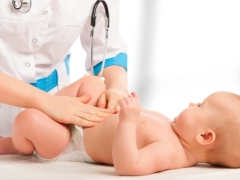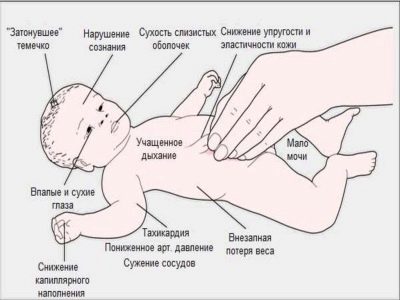Pyloric stenosis in newborns
In children's medical practice there are very dangerous conditions that require special treatment. One of these pathologies is pyloric stenosis.
What it is?
A pathological condition in which the pylorus is substantially narrowed is called pyloric stenosis. This pathology is most often congenital. Boys, according to statistics, are sick more often than girls. The first adverse symptoms of a congenital form of the disease appear already in newborn babies.
Pyloric stenosis can also be acquired. Typically, these clinical forms of the disease occur in older children. Most often this is a consequence of a severe form of gastric ulcer or a consequence of a chemical burn of the inner gastric wall. Congenital forms of the disease are found in children's practice much more often than acquired ones. Conducting conservative treatment in these situations is completely ineffective.
Currently, scientists have not established a single cause, which causes the development of a narrowing of the pylorus. They identify several causative factors that most often contribute to the development of the disease. These include:
- Various viral infections that the child suffered during fetal development.
- Complicated during pregnancy. Strong toxicosis, especially in the late stages of gestation, contributes to various disorders of organogenesis in the baby. After birth, the child has various anatomical defects in the structure of internal organs, as well as functional impairment, often manifested by pylorospasm.
- Long-term use of certain drugs.
- Pronounced endocrinological diseases in the future mother.
Various intrauterine pathologies lead to the appearance of clinical signs of pyloric stenosis in a child after birth. Normally, the pylorus of the stomach ensures the normal carrying of the food bolus along the digestive tract. This function is called evacuation. If food does not come out of the stomach and stagnates in it for a long time, then this ultimately leads to overstretching of its walls.
Violation of the evacuation of food contributes to the appearance of specific clinical manifestations in the baby.
Symptomatology
There are several stages in the development of the disease: compensation, subcompensation and decompensation. If the diagnosis of the pathology of the stomach was carried out out of time or the treatment is too delayed, then the extreme stage - decompensation - is reached rather quickly. The nature of this disease is progradient. Over time, the severity of symptoms only increases.
The initial stage of the disease in young children is not yet accompanied by the development of adverse symptoms. Usually at this time, the child is almost nothing worries. In some cases, the symptoms may be minimal, which does not cause any concern for the general condition of the baby on the part of the parents. Identify the disease, as a rule, already at a rather late stage.
The first symptom in infants, which should alert the parents, doctors believe the emergence of feelings of overflow in the epigastric region. After some time, the baby appears vomiting eaten food. In this case, pieces of food remain practically undigested.
This is an important diagnostic criterion for vomiting, which occurs precisely when pylorospasm.
As the disease progresses vomiting occurs almost after every meal. Even eating a little, the child feels a strong emetic urge. After vomiting, the baby feels much lighter. In the later stages of the disease, emetic urge arises in a child even after consuming liquids: compote, fruit drink, tea, juice, and even plain water. Such a pronounced vomiting leads to the fact that the baby loses a lot of weight. Pronounced electrolyte and metabolic disturbances appear in the children's body.
The prolonged stagnation of food in the stomach leads to an increase in its putrefactive and fermentation processes. As a result, chronic diseases of the organs of the gastrointestinal tract appear or escalate in the baby. Almost all babies with a long course of pyloric stenosis develop persistent chronic gastritis with impaired gastric secretion.
Disruption of food intake in the intestines leads problems with the absorption of various nutrients, as well as vitamins from food. This contributes to the fact that the baby is significantly lagging behind in physical development from their peers. Sick kids do not gain weight well, and in some cases even lose weight. Infants usually lag behind not only in physical, but also in mental development.
This feature is due to the need for optimal intake in nutrients and vitamins every day in early childhood.
Severe vomiting contributes to the development of many symptoms of dehydration in the baby. The skin of the child becomes very dry. Severe course of the disease contributes to the appearance of a characteristic appearance: the face is drawn out, the nose becomes aggravated, and the cheekbones are clearly outlined. The skin becomes pale, with fine blue veins appearing clearly visible on it. Visible mucous membranes turn pale, and an intolerable feeling of dryness appears in the mouth.
Severe and frequent vomiting contributes to the kid asks to drink more often. In severe stages of the disease it does not improve well-being, since drinking fluid only contributes to more frequent emetic urge.
In severely weakened and skinny babies, peristalsis of the stomach and its overflow become visible.
The lack of intake of essential nutrients leads to the fact that the baby constantly feels the growing feeling of hunger. High appetite persists for a long time in a child and only progresses with the development of the disease. Increasing vomiting leads to the fact that the baby appear pronounced constipation. Overflow of the stomach contributes to the appearance of pain in the epigastric region.
Diagnostics
When the first clinical symptoms of the disease appear, it is very important to see a doctor immediately. The doctor will conduct a full clinical examination and examination of the baby, which is necessary for making a correct diagnosis. During the examination, the doctor must palpate the abdomen and determine the size of the organs of the gastrointestinal tract.
The specialist will also be able to identify overflow in the stomach and assess the severity of other functional pathological conditions.
To establish metabolic disorders, the doctor will prescribe a child's blood test. Examine the organs of the gastrointestinal tract by using ultrasound. Another, more unpleasant study, is an endoscopic examination of the upper digestive system. Using special devices - endoscopes, doctors conduct an examination of all the anatomical sections of the stomach, as well as determine the presence and volume of stagnant contents in it.
In the later stages of the disease, endoscopic examination reveals signs of cicatricial stenosis. They can also be present in babies with acquired forms of pyloric stenosis, resulting from a chemical burn of the gastric mucosa with various substances. For older children in order to eliminate the narrowing of the pylorus is carried out radiography. It also helps to establish the degree of expression of existing anatomical defects.
Currently, radiography of the stomach in children is used less and less. This method has been replaced by various ultrasound examinations, which allow more accurately and reliably to clarify the presence of existing narrowing in the stomach. Ultrasound does not carry radiation exposure, as radiography, and therefore can be used even in the smallest patients.
In the diagnosis it is very important to distinguish organic (structural) defects from functional ones. Pyloric stenosis is an organic pathology characterized by the presence of marked narrowing in the pyloric region. Pilorospasm - a functional disorder associated with a violation of the nervous innervation of the body. In some cases, to conduct a differential diagnosis between these two pathological conditions, physicians resort to the appointment of course schemes of antispasmodics.
Usually the use of these funds leads to an improvement in well-being during pylorospasm and practically does not have a stable therapeutic effect in pyloric stenosis.
What is the difference between pylorospasm and pyloric stenosis in the next video.
Treatment
To eliminate the adverse symptoms of the disease, various types of surgical treatment are carried out. The operation is chosen by a pediatric surgeon, taking into account the initial state of the child, his age and the presence of concomitant chronic diseases in the baby. Most often, surgical treatment of pyloric stenosis is carried out in a planned manner.
In pediatric surgical practice is often used Fred-Ramstedt operation. This method is the most gentle for the tender body of a child. During the operation, surgeons perform a layered dissection of the mucous and muscular membranes, reaching the gatekeeper. During surgical treatment of the impact on the mucous membrane is not. Such a gentle technique can significantly reduce the likelihood of postoperative complications.
Having reached the narrowed department of the gatekeeper, doctors spend sequential opening of a dense muscular ring. This contributes to the fact that the mucous membrane can do away without applying surgical cuts on it. Subsequently, the size of the stomach gradually return to normal, and all the adverse clinical symptoms of pyloric stenosis completely disappear.
During the operation, doctors also work with the nerves that provide innervation of the stomach. This helps to consolidate the positive effect of the surgical treatment.
Even severe pyloric stenosis is an indication for surgery. If the child fails to perform surgical treatment, dangerous complications develop rapidly. In some cases, it can even be fatal. Pyloric stenosis is a rather dangerous clinical condition that requires immediate treatment.

























